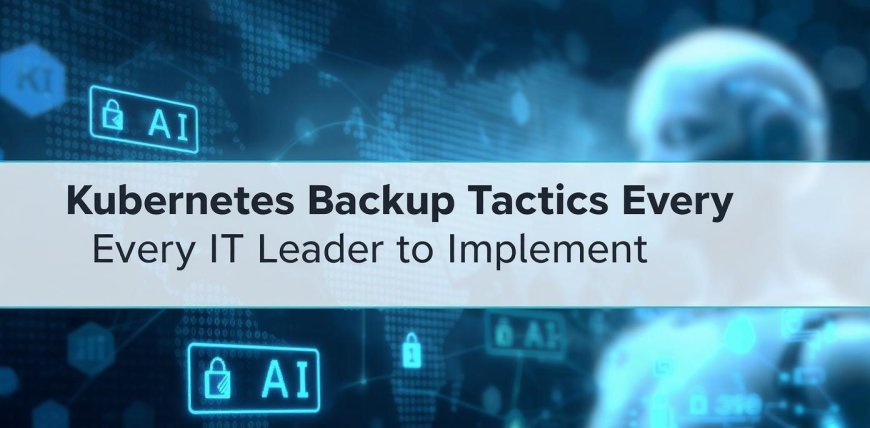Kubernetes Backup Tactics Every IT Leader Should Implement
As cloud-native adoption continues to rise, Kubernetes has become the foundation of modern application infrastructure. With this shift, ensuring data protection in dynamic, containerized environments is more critical than ever. The 5 Best Practices for Kubernetes Backup offer a proven roadmap for IT teams looking to minimize data loss, reduce recovery times, and ensure continuity across environments.

As cloud-native adoption continues to rise, Kubernetes has become the foundation of modern application infrastructure. With this shift, ensuring data protection in dynamic, containerized environments is more critical than ever. The 5 Best Practices for Kubernetes Backup offer a proven roadmap for IT teams looking to minimize data loss, reduce recovery times, and ensure continuity across environments.
This blog explores the actionable insights from the 5 Best Practices for Kubernetes Backup, equipping businesses with a framework to strengthen their backup strategy for Kubernetes clusters.
Why Kubernetes Backup Requires a Unique Approach
Unlike traditional monolithic applications, Kubernetes introduces complexity with distributed, ephemeral components. Containers spin up and down rapidly, workloads scale automatically, and critical configurations like secrets, volumes, and services must be maintained.
The 5 Best Practices for Kubernetes Backup recognize these differences and propose a specialized approach. Organizations that rely on legacy backup tools often find themselves unprepared when disaster strikes in a Kubernetes ecosystem. Whats needed is a native, intelligent, and resilient strategy that goes beyond simply copying data.
Choose Kubernetes-Native Backup Tools for Full Visibility
One of the most fundamental 5 Best Practices for Kubernetes Backup is to implement a backup solution designed for Kubernetes environments. Generic solutions often fail to recognize pods, deployments, CRDs, and service dependenciesleading to incomplete restores.
Kubernetes-native backup platforms interact directly with the Kubernetes API, dynamically discovering resources like namespaces, volumes, and workloads. These tools support volume snapshotting, backup of configuration files, and restore capabilities that respect the stateful nature of containers.
Look for features such as CSI (Container Storage Interface) support, workload-aware policies, and RBAC integration to ensure operational excellence.
Leverage Granular Backup and Restore Capabilities
Not all failures require full-cluster recovery. Another key takeaway from the 5 Best Practices for Kubernetes Backup is the importance of fine-grained backup strategies. Granular control allows users to back up specific namespaces, labels, secrets, or persistent volumes and restore only what is needed.
This approach is especially beneficial in DevOps workflows where frequent changes occur, and rapid rollback is essential. Granular restores minimize downtime and prevent unnecessary disruption to healthy components of the cluster.
Application-aware backup logic also ensures consistent backup of databases and distributed systems running in Kubernetes.
Enable Portability Across Clouds and Environments
With multi-cloud and hybrid strategies becoming the norm, portability is a top concern. The 5 Best Practices for Kubernetes Backup emphasize that backup solutions should support seamless mobility of workloads across cloud providers and Kubernetes distributions.
A robust backup tool should allow teams to replicate applications and their dependencies between Amazon EKS, Azure AKS, Google GKE, and on-prem clusters. This capability is vital for disaster recovery, staging, and blue/green deployments.
Workload portability ensures that your business can scale and adapt without lock-in to a single platform.
Automate Policies and Enforce Backup Compliance
Manual backups are unreliable and inefficient. Automating policies is a core component of the 5 Best Practices for Kubernetes Backup. Modern backup platforms allow administrators to define policies based on namespaces, labels, and schedulesensuring protection coverage aligns with business priorities.
Automation reduces human error and improves SLA adherence. Scheduled backups, retention enforcement, and lifecycle management streamline operations and ensure that critical data remains protected and compliant with industry standards.
Additionally, automatic testing of backup integrityvia scheduled restoresensures that data is not just stored, but usable.
Prioritize Backup Security with Encryption and Access Controls
Security is the final pillar of the 5 Best Practices for Kubernetes Backup. A backup is only as good as its protection against unauthorized access. It is essential that backups are encrypted in transit and at rest using strong encryption protocols.
Integrating identity and access management systems like LDAP, OIDC, or SAML provides secure, role-based access to backup systems. Backup data should be stored separately from the production cluster to prevent cascading failures in the event of a breach.
Audit trails and immutable backup policies offer additional layers of security against tampering or ransomware threats.
Businessinfopro Empowers Kubernetes Backup Success
At Businessinfopro, we work with forward-thinking enterprises to implement the 5 Best Practices for Kubernetes Backup, using a combination of native tools, automation frameworks, and cloud-native strategies. Our experts help organizations minimize data loss, reduce recovery time, and ensure resilience in Kubernetes environments.
Whether your workloads run on EKS, AKS, GKE, or on-prem clusters, our approach ensures that your data and infrastructure remain protected and portable.
Read Full Article : https://businessinfopro.com/5-best-practices-for-kubernetes-backup/
About Us: Businessinfopro is a trusted platform delivering insightful, up-to-date content on business innovation, digital transformation, and enterprise technology trends. We empower decision-makers, professionals, and industry leaders with expertly curated articles, strategic analyses, and real-world success stories across sectors. From marketing and operations to AI, cloud, and automation, our mission is to decode complexity and spotlight opportunities driving modern business growth. At Businessinfopro, we go beyond newswe provide perspective, helping businesses stay agile, informed, and competitive in a rapidly evolving digital landscape. Whether you're a startup or a Fortune 500 company, our insights are designed to fuel smarter strategies and meaningful outcomes.
































